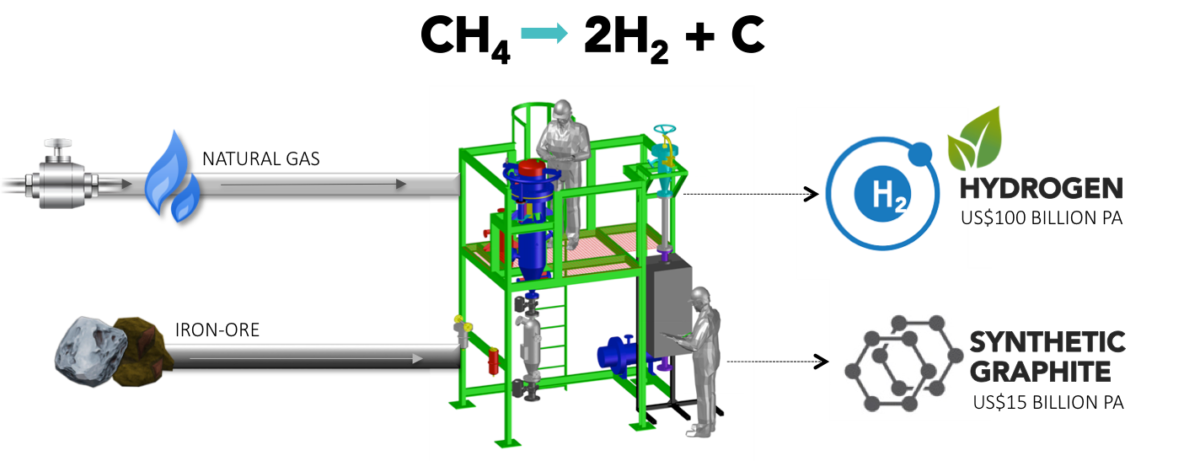Marking an important milestone for its innovative wastewater-to-renewable hydrogen project, Hazer Group has announced that it had received binding commitments to raise $8.4 million. The share placement had to close early due to strong demand, exceeding the initial target of $6 million and highlighting the strong interest in Australia’s emerging green hydrogen industry.
A total of 20 million shares will be issued to sophisticated and institutional investors at $0.42. The issue price represents a discount of 26.3% to the last traded price of $0.57 and a discount of 17.5% to the volume-weighted average market price of the company’s shares on the ASX during the last 15 trading days. The company also announced that it has executed a non-binding term sheet for a $6 million loan facility from Mitchell Asset Management.
The money raised will be used to construct Hazer’s Commercial Demonstration Plant (CDP) and support its ongoing research and development. The proposed Hazer Process CDP is a 100 tons per annum, low-emission hydrogen production facility that will convert bio-methane to renewable hydrogen and produce 380 tonnes graphite annually using an iron ore catalyst.
“With the completion of this funding package, Hazer is strongly positioned to construct, commission, and operate our Commercial Demonstration Project, a major milestone in scaling up the Hazer technology,” said Hazer Group Chairman Tim Goldsmith. “I look forward to working with the Hazer team to finalize the project arrangements and take a final investment decision on the project in the immediate future.”
UWA technology
Hazer’s CDP is proposed to be located at the Woodman Point Wastewater Treatment Plant in Munster, just south of Fremantle, in Western Australia (WA). As the first large-scale, fully integrated deployment of the Hazer Process, the CDP represents the key step in fully commercializing the technology, originally developed by the University of Western Australia (UWA).
The technology capitalizes on the waste product of biogas that is released during the wastewater treatment process as solid matter – biosolids. While most of this renewable fuel is currently used to produce electricity for the treatment plant, the excess is usually burned off – now it will be converted into valuable materials using an iron ore catalyst.
Professor Hui Tong Chua from UWA’s School of Engineering led the initial research to develop hydrogen by breaking the chemical bond of gas methane. “This is a marvelous application of the Hazer process onto renewable biomass, with the carbon being sequestered as solid graphitic carbon, which has potential applications in batteries,” he said.
As an alternate hydrogen pathway to the traditional approaches of steam methane reforming and electrolysis, the Hazer Process aims to achieve savings for hydrogen producers, as well as provide green hydrogen to be used in a range of clean energy applications and large chemical processing industries.
Backing
Last year, the project won the backing of the Australian Renewable Energy Agency (ARENA) to the tune of $9.4 million. In its latest update, the company said that ARENA’s funding is still subject to conditions including a biogas supply agreement, a hydrogen offtake agreement and Hazer securing sufficient finance for the completion of the project.
In May, the company announced the execution of a binding agreement with Water Corporation for the supply of biogas and co-location of the CDP at its plant in Munster. Previously, Hazer announced the signing of a non-binding term sheet with BOC for hydrogen offtake from the proposed Hazer CDP.
While a binding agreement with BOC is still in the works, Hazer says that it has in parallel identified other hydrogen use opportunities including for self-consumption. The company continues to work with ARENA to satisfy the remaining conditions and secure the funding, which would account for 41% of the total costs ($7.9 million), including a contribution to operating costs ($1.5 million).
The project has also won the backing of the WA state government since it aligns with its Renewable Hydrogen Strategy, set up to position WA as a major producer, user and exporter of renewable hydrogen.
The design and construction phase of the project is scheduled to be completed in December 2020, with operations running from January 2021 to December 2023. As announced earlier, Hazer plans to sell renewable hydrogen for industrial applications and is exploring markets for graphite including carbon black, activated carbon, and battery anode applications.
This content is protected by copyright and may not be reused. If you want to cooperate with us and would like to reuse some of our content, please contact: editors@pv-magazine.com.









By submitting this form you agree to pv magazine using your data for the purposes of publishing your comment.
Your personal data will only be disclosed or otherwise transmitted to third parties for the purposes of spam filtering or if this is necessary for technical maintenance of the website. Any other transfer to third parties will not take place unless this is justified on the basis of applicable data protection regulations or if pv magazine is legally obliged to do so.
You may revoke this consent at any time with effect for the future, in which case your personal data will be deleted immediately. Otherwise, your data will be deleted if pv magazine has processed your request or the purpose of data storage is fulfilled.
Further information on data privacy can be found in our Data Protection Policy.